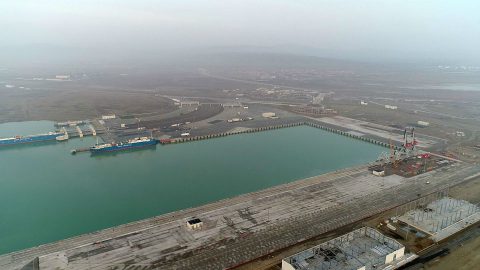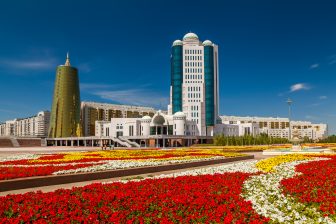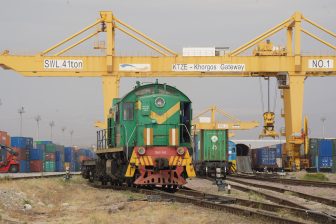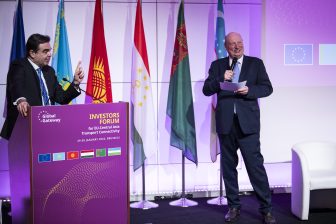
Port of Baku: everything comes together in Alat
The multimodal route via the port of Baku connecting Europe and China will grow, regardless of what important transit countries such as Russia do on the New Silk Road. This is the view of Tural Aliyev, Advisor to the Director-General of Port of Baku. The Middle Corridor has a lot of potential to be a stable route on the New Silk Road, he says.
Aliyev is one of the speakers at the European Silk Road Summit, to take place from 26 to 27 November in Venlo, the Netherlands. The port of Baku is currently in a development process to live up to its growing importance. A new port was opened last year in Alat, with many development phases still on the agenda. With such steps, it hopes to become a major consolidation and distribution center in the region.
Viable alternative
The Middle Corridor transfers cargo from China to Europe via Kazakhstan, Azerbaijan, Georgia and Turkey or Ukraine. It is a multimodal route with a sea leg through the Caspian Sea. The popularity of the route was accelerated with the Baku-Tbilisi-Kars railway, which improved the railway connectivity of the port to Turkey. The route would be a viable alternative to the regular railway route via Russia.
This was especially true for sanctioned goods. Up till now, fresh goods from Europe could not be transported through by rail through Russia and hence, this large market was in need of alternatives routes into China. The interest in the Middle Corridor was by many explained in this light; the travel times may be a little longer and the costs higher, but still competitive with air and ocean freight.
Not worried
However, in July the Russian government lifted the ban. It is only matter of time until the first shipment of fresh goods find their way through Russia. The focus of many logistics providers immediately shifted to the trusted, conventional route to China, via Russia and Kazakhstan.
But this certainly does not mean that the potential of the Middle Corridor is hampered, Aliyev says. “Fresh goods were never the dominant share of volumes via the Middle Corridor. We see electronics, high-end consumer goods. About the same type of products shipped via the regular route”, he portrays.
According to the Azerbaijani, the attractiveness of the Middle Corridor is in that it is a safe and stable route. “There is no political tension in the countries involved, and no such circumstances as a ban in place. This is why shippers opt for a route as the Middle Corridor; they know it is a stable corridor where sudden problems are not likely to occur.”
Transshipment
However, there are other challenges on the multimodal route. In Baku, the cargo needs to be shipped onto a vessel. This ship carries the load to the Kazakh port of Aktau or port of Kurik, where it is stacked upon another train. Such transshipment procedures leave space for delays, an argument for some to refrain from the Middle Corridor.
The ferry vessels currently depart minimally twice, maximally four times per day between the ports, says Aliyev. Container vessel departs once per week. Once the demand increases this should become a regular service. However, there are only two to three vessels available. “We do not have enough dedicated ships at the moment.”
Nevertheless, the reliability of the service is good, he continues. “The strength of the product is that it is a cooperation between all those involved, united in the The International Trans-Caspian Transport Consortium. The train passes through Ukraine, Turkey, Georgia, Azerbaijan and Kazakhstan. This means a lot of borders and procedures to deal with. But customers do not have to deal with all these procedures; we offer one single logistics product.”
Volumes
The Coordinating Committee of the Consortium decided to establish the ITrans-Caspian International Transport Route and started promoting the multimodal route in 2016, Aliyev says. We still have a lot of work to do in this regard. But we have seen the volumes grow. Last year a total of 3.2 million tonnes of freight was forwarded between East and West. In the third quarter of 2019 this was already 3 million tonnes.”
When the Middle Corridor presented its 2019 transportation plan at the first general meetings of this year it spoke of increasing container transport volumes to reach the level of 60 thousand TEU’s. The targeted volume in 2018 was 15 thousand TEU’s, and this was exceeded, commented the association.
Larger region
One should not forget that the focus of the port is not on Eurasian cargo streams alone. The port has the strategic location to serve a huge market stretching from Iran in the south to Russia in the north. Within a 1000 km distance Azerbaijan provides access to a huge B2C market of over 130 million people and 770 billion in GDP, Aliyev points out.
From this perspective, everything comes together in the new port of Alat, where main international rail routes converge: from Iran passing through Baku to Russia/North Europe; from China passing through Azerbaijan to the shores of the Black Sea and Turkey.
Distribution hub
“Once a vibrant route for the Silk Road trade, Central Eurasia is poised to regain its historical role as a commercial bridge between east and west, north and south” the port states on its website. “Azerbaijan is located at the crossroads of major Eurasian land and air transport corridors- feature that will play a vital part in its long-term success, if utilised properly. Potentially, the country could serve not only as a commercial bridge between Europe and Asia, but also as a major distribution hub in Eurasia.”
Towards this end, it is launching phase after phase to become bigger, more advanced and more attractive. It recently signed an agreement with DP World to set up a Free Trade Zone at the port. This will provide a wide range of value added services for companies in the region. Currently, about 80 per cent of cargo is deemed for transshipment. This split could be changed with the new Free Trade Zone, the port expects.
European Silk Road Summit
Do you want to hear more about the port of Baku and its ambition to become a Eurasian hub? Tural Aliyev will speak at the European Silk Road Summit, in a session about the role of the ports. The programme of the event can be found on the website.





